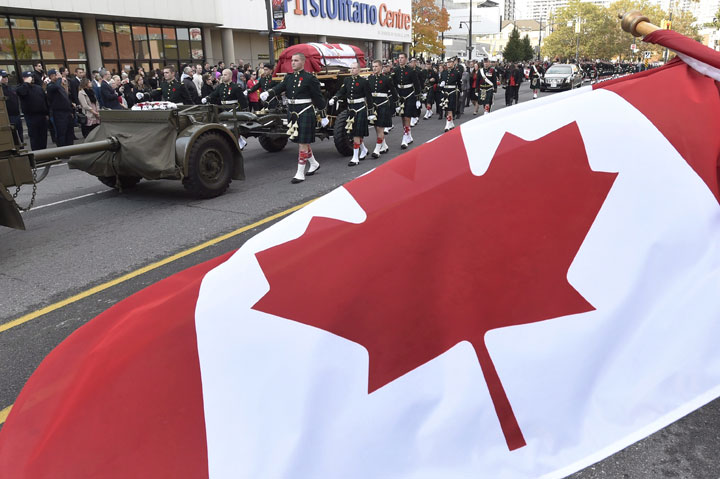OTTAWA — Some of the Canadian men and women in Iraq —where a special forces member’s blood was tragically shed last week —will see fewer benefits if they’re hurt or killed.

Ottawa won’t say how many, though, citing security reasons.
“This mission … incorporates a mix of regular force, reserve force and civilian personnel,” a National Defence spokeswoman wrote to Global News.
Canada’s military reservists are among the 600 troops deployed in Iraq, where Sgt. Andrew Joseph Doiron was killed in an incident that left three other Canadian soldiers injured.
All four were regular force members.
READ MORE: Kurd official says Canadian soldier killed in Iraq after group ignored order
With the physical threat of the anti-terror mission in full view, the federal government has yet to live up to a months-old promise to remedy the multi-million-dollar inequity facing the families of reservists killed in the line of duty.
Nor can Canadians know how many reservists are risking their lives in Iraq and so at risk of receiving fewer benefits than their regular force compatriots.
National Defence said the exact makeup of forces members deployed in Iraq is secret “for security reasons.”
“This is done to ensure enemy forces have as little information at hand that could be used against our men and women deployed.”
READ MORE: Killed, injured Canadian troops acted professionally, Defence Minister says
The spokeswoman said the policy was not in any public document and said she couldn’t explain why the policy was different than when the troops were in Afghanistan, when National Defence offered updates on the percentage of reservists taking part in the mission.
While informing the public, National Defence’s priority is to “minimize the information that could be used against CAF personnel, sometimes in yet to be anticipated ways,” Archambault said.
Global News in October uncovered the discrepancy between the values the government places on the lives of reservists and regular forces members in the military, following the violent deaths of Warrant Officer Patrice Vincent and Cpl. Nathan Cirillo.
Though both men were honoured, the life of either man was valued very differently, according to the federal rules.
READ MORE: Reservist inequality persists months after Ottawa promised action
In November though, the Conservative government said it would change the reservist death benefits, but the inequality persisted months later.
- What is a halal mortgage? How interest-free home financing works in Canada
- Capital gains changes are ‘really fair,’ Freeland says, as doctors cry foul
- Budget 2024 failed to spark ‘political reboot’ for Liberals, polling suggests
- Peel police chief met Sri Lankan officer a court says ‘participated’ in torture
The office of Veterans Minister Peter O’Toole did not respond to emails sent Tuesday morning asking for an update on any changes to the policy.
As it stands, Cirillo was a Class B reservist with fewer than 180 days of service under his belt for the year. As such, according to government policy, his survivors – including his five-year-old child Marcus – are officially entitled to far less than those of any regular force members.
The government agreed to give Cirillo’s family the more generous benefits available to families of regular service members, but that menat the feds were effectively bending their own rules.
READ MORE: Reservists like Nathan Cirillo are worth $1.8M less to the feds. Why?
According to official figures obtained by Global News, a person in Cirillo’s position would not have been entitled to a supplementary death benefit, worth $113,136 for regular force corporals, and would have received, at most, a negligible superannuation survivor benefit, which is worth $2,828 annually for regular force corporals until the decedent would have turned 65.
Survivors of a person in Cirillo’s position would also receive a lower supplementary retirement benefit – $17,000 compared to $41,833.
Most significantly, however, they would receive substantially less of an Earnings Loss Benefit – upwards of 70 per cent less over the lifetime of the benefit, which in his case would be $24,300 a year until he would have turned 65; by comparison, a regular force corporal’s earnings loss benefit begins at $42,426 and increases by 2 per cent annually.
By the time these benefits expire for a person of Cirillo’s age and rank, the survivors of a regular force corporal of the same age who died the same year would have received about $1.8 million more, in total, than Cirillo’s beneficiaries.




Comments